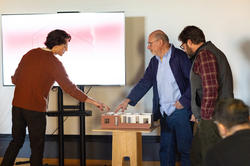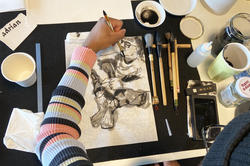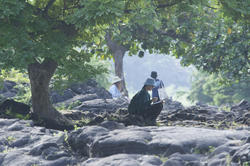A fall studio supported state leaders’ ongoing efforts to address homelessness in Rhode Island.
RISD Students Travel to Japan to Explore Cultures, Traditions and Contemporary Design

The world’s population is projected to reach 9.7 billion by the year 2050, and nearly 70% of those people are expected to live in cities. But in Japan things are moving in the opposite direction, with populations shrinking across the country and urban centers becoming less and less lively. Japanese native Junko Yamamoto, who began teaching in RISD’s Architecture department last year, has seen these changes first-hand and was inspired to develop a Wintersession travel course for RISD Global that would allow students to experience Japanese culture and consider the design needs of an aging population.
“I’m from a rural community in Japan and traveled abroad—to the US—for the first time when I was 12 years old,” Yamamoto says. “That experience changed everything for me. Now that I am an educator, I am passionate about creating life-changing international experiences for my students.”
The outcome of her efforts is Post-Urban Japan: Tradition to Contemporary Design, a 19-day adventure led by Yamamoto and fellow Architecture faculty member Armando Hashimoto that brought 14 students from a variety of disciplines to cities like Tokyo and Osaka and smaller, less touristy communities in Gunma (Yamamoto’s home prefecture). They visited design studios and ateliers, museums, noted examples of Japanese architecture and more.


“Being exposed to new cultures, places, people and languages is an opportunity to experience heightened sensibilities, increased appreciation for differences and similarities, broader perspectives and a deeper understanding of others and ourselves,” says Yamamoto. “That kind of experience is indispensable in design education.”
Before the class left for Japan, each student was assigned a research project focused on several of the sites the group would be visiting. Over the course of the trip, each student thus had the opportunity to act as a tour guide.
“My favorite tour was on the islands of Naoshima and Teshima,” says Hashimoto. “The combination of bicycles, sunny skies, incredible topography and art, the sea and the group experience was wonderful. We also attended a great lecture at the University of Tokyo by Kayoko Ota—an architectural curator—who talked about the need for architects to produce alternative visions to corporate, capital-based megaprojects.”


Students were also expected to create daily Instagram posts reflecting on the insights of the day and responding to the course’s overarching theoretical question: “What if Tokyo becomes a forest?” They broke up into teams of two (one Architecture major and one not) to speculate about the idea and brainstorm possible futures for a post-urban forest. When they returned to Providence, each student presented their final project to the class.
Graphic Design major Leslie Berumen Flores 24 GD imagined a world in which wayfinding and transportation would be difficult and proposed a “bright and clear visual language to contrast the chaos and overgrowth of vegetation.” She created a visual identity system that included icons specific to speculative future conditions such as “Beware of Wild Boars” and “Collapse Risk.”
Sophomore Maggie McCreery 26 FD speculated that unfinished building projects, empty lots and other vacant spaces would become the birthplace of growth. She made a series of paintings on wood panels depicting the neglect, decay and eventual reclamation of the built environment by both human and non-human communities. “The paintings show the possibilities of a depopulated future that repurposes unsuitable/neglected structures to bring communities together,” she explains.
“Setting up those architect/non-architect student collaborations prompted an unexpected and powerful layer of storytelling,” says Hashimoto. “It led to projects that address a strategic and futuristic perspective but also the experience and sensations of that projected change.”
Simone Solondz / top photo: the class visits an award-winning plaza at the Kanagawa Institute of Technology
March 7, 2024


